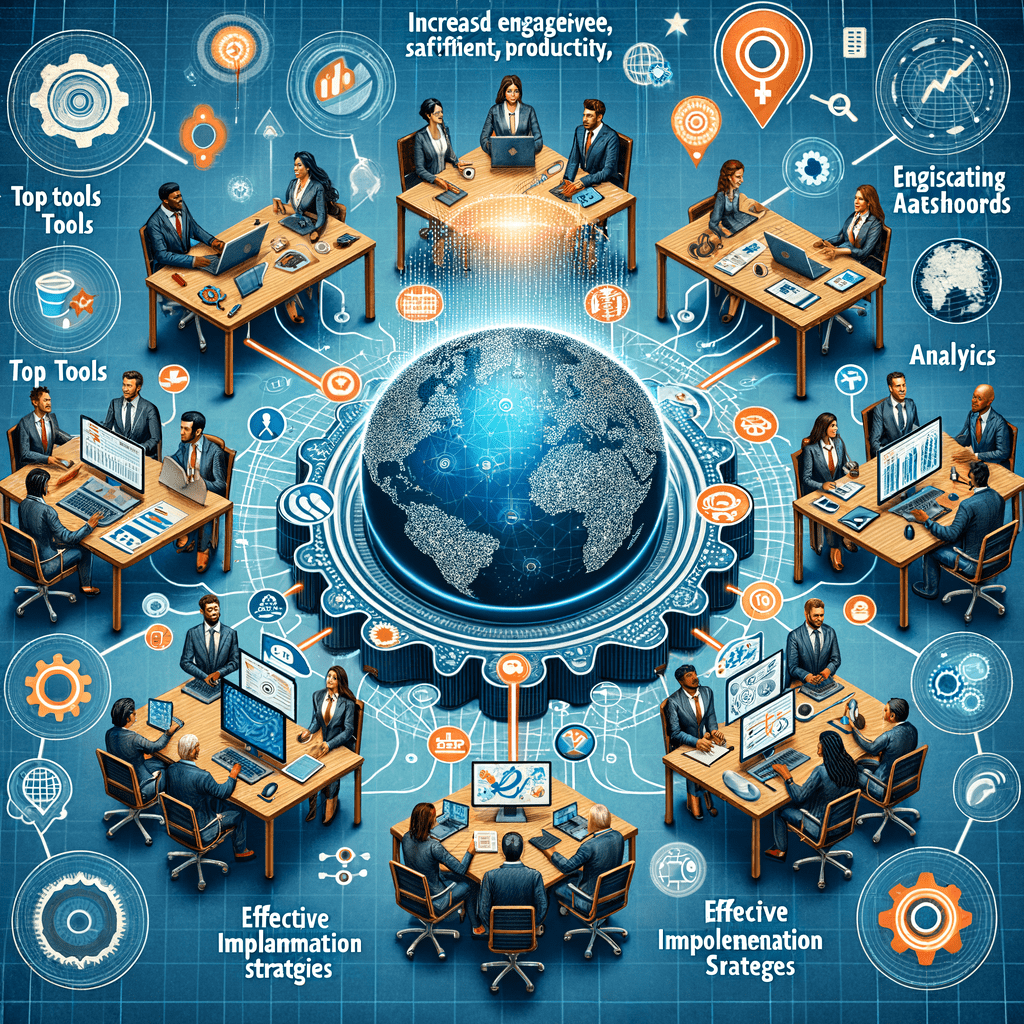AI tools for employee engagement are rapidly changing how companies interact with their workforce. This shift is driven by the need for more personalized and effective engagement strategies in today’s dynamic work environment. Is artificial intelligence for employee engagement just a fleeting trend or a real game-changer? Let’s find out.
The Power of AI in Employee Engagement
Companies are adopting AI at a fast clip. The SHRM State of the Workplace Study shows a significant uptick in HR departments either using or planning to use AI.
What’s the big deal? This growing trend shows increasing reliance on AI employee engagement solutions. AI can help people perform better, while mitigating risks such as bias.
AI Tools for Employee Engagement: A Practical Guide
Many believe that using these tools is complicated. The potential benefits of AI for engagement are significant and catching on.
They offer personalization, provide real-time insights, and utilize data-driven tools.
Feedback and Surveys
AI-powered tools analyze large amounts of employee feedback. They identify trends and sentiments, giving managers valuable insights for quick action. AI algorithms sift through employee data, uncovering hidden patterns and providing ai-powered insights to hr professionals.
Recognition and Rewards
AI can personalize recognition and rewards programs. AI systems analyze employee performance data and link rewards with achievements. Platforms like LumApps help businesses acknowledge and appreciate employees promptly, enhancing employee recognition.
Training and Development
Forget generic training programs. AI tailors learning experiences based on individual needs and skill gaps.
Personalized learning recommendations and AR/VR experiences create impactful development programs. This allows for opportunities to analyze employee performance and track employee progress for hr decisions.
Communication and Collaboration
AI-powered chatbots and virtual assistants act like always-available help desks.
Tools like LumApps streamline internal communication. They help manage repetitive tasks, freeing up employees for more strategic work, enhancing employee engagement by use of natural language processing for more engaging internal communication.
Performance Management
AI can make performance reviews more data-driven and objective.
This supports, but doesn’t replace, human interaction. Continuous feedback and data-driven suggestions help managers guide employees effectively. Real-time tracking keeps performance clear, as described in these AI-powered tools, and helps automate performance appraisals and analyze employee performance data to improve employee productivity. This also gives better ways ai can work with businesses.
How AI Enhances Employee Engagement Strategies
Integrating AI into employee engagement strategies requires a thoughtful approach. There are privacy issues, and employees might feel concerned about potential biases. Clear communication and demonstrated value can ease concerns.
Data-Driven Decisions
AI transforms raw employee data into understandable stories, according to Qualtrics.
These data-driven insights enable action over guesswork. A Sage study highlights the gap between HR leaders’ belief in data-driven decisions and their implementation. AI bridges this gap by empowering HR teams with accessible insights. AI helps by providing access to previously unseen areas for improved hr strategies and by supporting generative ai driven insights and predictive analytics. This supports hr teams by giving access to advanced machine learning and an enhanced engagement platform for management systems ai.
Improved Employee Experience
Employee experience boils down to closing gaps between employee needs and what they receive. Using data to gain these insights and address negative feelings fosters better relations and employee satisfaction. Utilizing language processing helps analyze employee feedback to determine trends and sentiments and provide data to enhance the work environment.
Enhanced Trust
Many people feel uneasy about AI, given privacy and bias concerns. To foster engagement with AI, businesses must prioritize transparency and responsible implementation. Addressing concerns promptly encourages employee acceptance of AI and builds a supportive employee support system, ensuring employee satisfaction with new ai technology. It’s another important way ai helps businesses and is critical for effective ai employee engagement and virtual assistants.
Gamification and Engagement
Adding game elements boosts employee morale, according to Finances Online. A Freshworks study found that many employees view AI as supportive in work tasks.
This trend is more prevalent among younger demographics, suggesting expanded use in business practices. Data suggests employee trust in technology is increasing. This increased reliance on ai employee engagement tools creates a more exciting and effective workplace as well as boosting employee engagement and driving improvements in customer service through routine task automation and more effective engagement strategies.
Real-World Examples of AI in Action
Companies such as IBM recognize the growing importance of AI. Businesses are adopting these AI programs worldwide. Social media companies are also developing new AI tools. It is rapidly improving many performance management systems as artificial intelligence works more deeply within business structures.
Automating Routine Tasks
Workers using automation save over three hours of administrative work weekly. Many organizations report a measurable return on investment from AI engagement tools. This boosts efficiency and allows HR to focus on strategic initiatives, reducing repetitive tasks, administrative tasks, and routine tasks. Streamlining these repetitive tasks leads to enhancing employee engagement and enhancing employee performance by utilizing these tools.
Personalized Onboarding with AI
Imagine automated onboarding paperwork. AI tools pre-populate forms and provide essential information, creating a smooth onboarding experience for new hires.
AI-Driven Learning Platforms
Platforms like Leena AI curate personalized learning. This fosters active engagement, making employees stronger team members. 68% of companies use AI for better hiring decisions. This is critical in using and analyzing employee performance data, improving performance appraisals, improving performance management systems, providing employee listening opportunities, and overall improving performance management and offering ai-powered insights into employee engagement.
Addressing Concerns and Challenges
While companies should explore AI solutions, proceeding with caution is also wise.
Data Privacy
Data privacy and bias are key concerns. AI gathers vast amounts of employee information. While this facilitates meaningful engagements, careless practices could lead to complications. Any engagement solution and employee engagement solution must be sure to not abuse any of the access to data for engagement ai.
Bias
Biases can infiltrate AI systems if the historical data used reflects those biases. AI shouldn’t amplify existing inequalities. This is crucial in the data that management systems ai can access, as we would want to avoid systems ai offering suggestions and providing ai-powered insights based on incomplete or bad data for engagement employee relations. Therefore proper employee data privacy must be managed and maintained for an ethical ai employee engagement solution.
FAQs about AI tools for employee engagement
How is AI used in employee engagement?
AI personalizes employee experiences, automates tasks, analyzes feedback, and provides insights to improve engagement strategies. This includes personalized onboarding, targeted learning and development, automated performance reviews, and real-time feedback. Increasing employee engagement using AI means creating unique and satisfying interactions. This creates ways ai can further optimize work for the future.
What are the best AI tools for HR?
Leading AI tools include platforms like Leena AI, Glint, Workday, Peakon, and Culture Amp.
Effective HR strategies combine technology and human interaction. Employee engagement is crucial for productivity.
What are the 5 C’s of employee engagement?
Several “C”s are associated with workplace improvement. While these aren’t fixed, they offer principles to guide AI enhancements in HR:
- Connect: Creating connected work.
- Career: Supporting career growth.
- Clarity: Making roles very clear.
- Convey: Clearly presenting values.
- Celebrate: Acknowledging success.
Variations of “the 5 C’s of engagement” exist. These ideas offer managers insight for personalizing strategies and enhancing employee relations.
What is the most commonly used tool to measure employee engagement?
Surveys remain the most popular way to track engagement, offering direct feedback according to Gallup.
Conclusion
AI tools for employee engagement offer tremendous potential but require a careful, ethical approach. These tools should be seen as aids for HR teams, empowering them to excel, not as replacements. Ignoring the current trends using AI tools could be detrimental. AI is changing how we approach employee engagement, driving better employee experiences, and improving performance for companies who embrace engagement tools.






